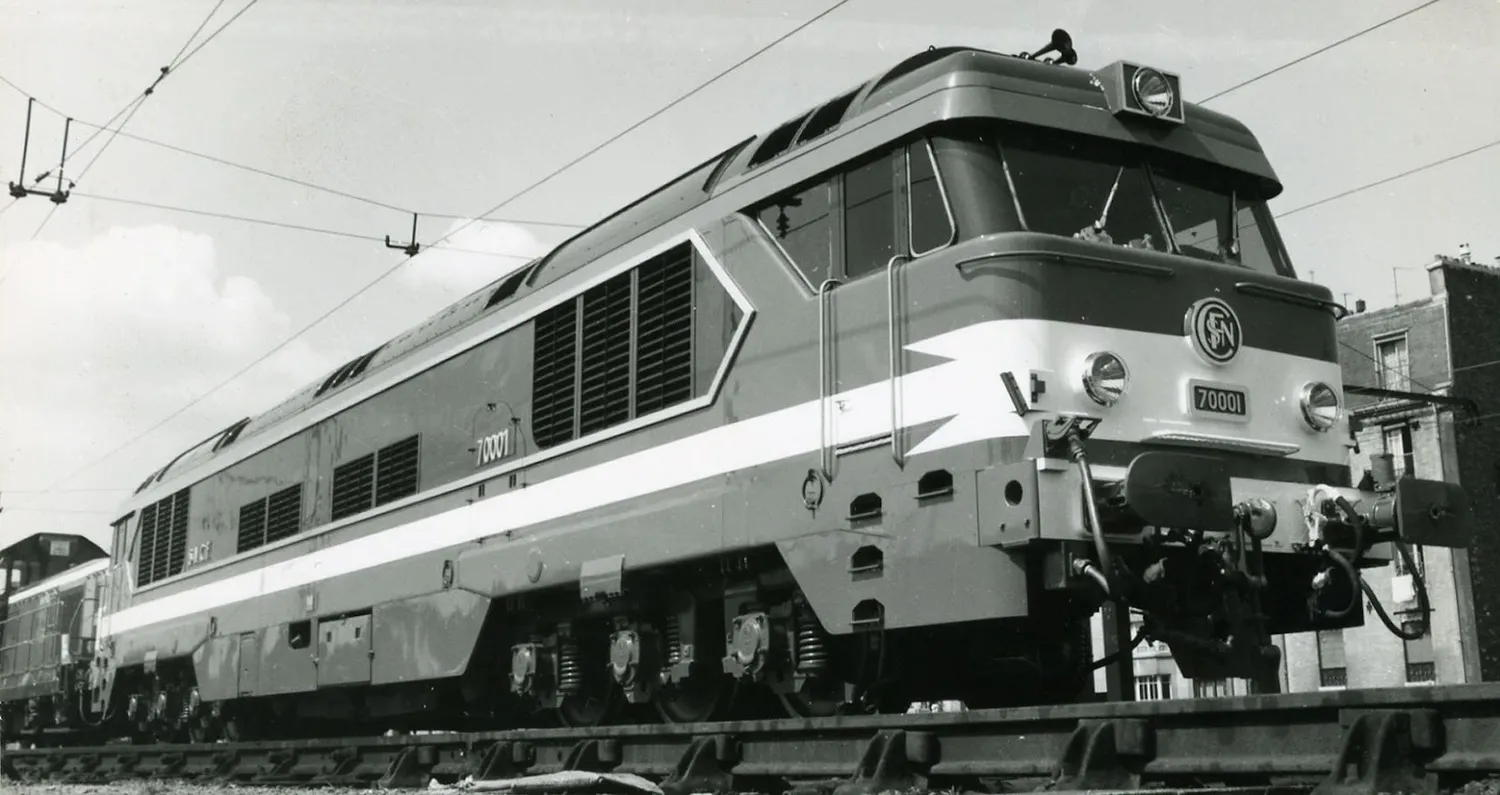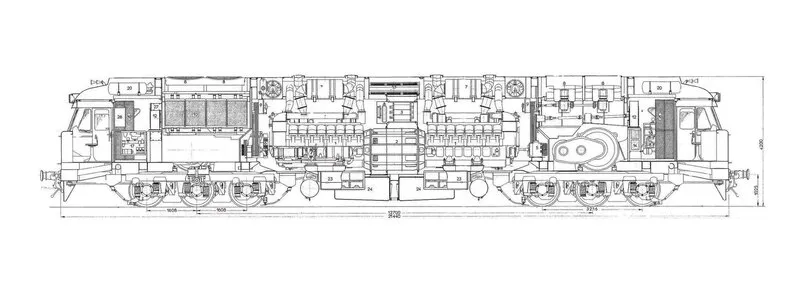CC 70000
Vehicle type:
Registration country:
Railway companies:
In service:
from 1965
Era:
III - IV
Built by:
Gauge:
Standard gauge (1'435 mm)
Wheel arrangement:
C'C'
Length over buffers (mm):
22'730 mm
Width (mm):
2'900 mm
Height (mm | over lowered pantograph):
4'200 mm
Wheelbase (distance between bogies centers) (mm):
15'916 mm
Tare weight (t):
117 t
Power output (x'xxx kW / x'xxx hp):
3'000 kW
Wheel diameter (x'xxx,xx | mm | new / worn):
1'050 mm
Maximum speed (km/h):
140 km/h
1961
The CC 70001 and CC 70002 are two
prototypes of high-power diesel-electric locomotives built for the
SNCF, contemporary with the
BB
69000. These locomotives adopt a dual propulsion
technique and a bi-rotor alternator, but this technology proves to
be insufficiently reliable. Designed to meet the needs on the
non-electrified lines of the SNCF, they aim to approach the power
of steam locomotives of the Mountain type while being capable of
providing electric heating for passenger trainsets. At the time of
their design, the power of diesel engines reached about 2,700 hp,
making dual propulsion necessary. The alternator generates
three-phase alternating current for electric heating, while the
traction motors operate on direct current, requiring a
rectifier.
The operation of these locomotives relies on a SEMT Pielstick 16PA4 diesel engine that drives the rotor of the Alsthom ATD2 alternator, while another engine rotates the inductor in the opposite direction. Each engine runs at 1,500 rpm to achieve a relative speed of 3,000 rpm, thus eliminating the need for gearboxes. A rectifier converts the three-phase current into slightly pulsating direct current, supplying the two traction motors, one per bogie, of type TAO 656 A. The bogies, closely derived from those of the CC 40100, allow for two-speed operation: 85 or 105 km/h for freight and 140 km/h for passenger services, with the regime change needing to occur at a stop for the CC 70001, but able to be done at low speed for the CC 70002.
Measuring 22.73 m long without buffers, the CC 70000 remain, in the 21st century, the longest single-body diesel locomotives of the SNCF.
Their livery, designed by Paul Arzens, is inspired by that of the BB 67000 and A1AA1A 68000, combining light and dark "diesel blue" tones with white stripes, reproducing the characteristic arrow of Arzens' productions at the level of the side grilles.
The locomotives were ordered from Alsthom in November 1961. The CC 70001 was assembled at the Belfort factory and entered service on December 17th, 1965, followed by the CC 70002 on July 1st, 1966, both assigned to the Chalindrey depot. In June 1966, the CC 70001 covered 26 840 km in one month, demonstrating its good mileage performance. The CC 70002 conducted tests on the Alps line between Grenoble and Veynes in September 1966 and June 1967. In April 1967, the CC 70002 participated in a test train between Rouen and Le Havre, reaching a speed of 160 km/h.
The services performed included routes between Grenoble - Veynes, Paris-Est - Troyes - Belfort - Mulhouse - Basel, and Saint-Dizier - Chaumont - Dijon, as well as the mineral water trains. The Chalindrey railway depot provided maintenance for both units from their entry into service until their retirement, with only staff from this depot and the one in Chaumont authorized to operate them.
However, due to reliability issues and the rise of the CC 72000, the CC 70000 were withdrawn from passenger service and assigned to other tasks, including mineral water trains departing from Vittel and Contrexéville. Frequent mechanical and electrical incidents led to their retirement, with the CC 70002 being withdrawn in 1973 after a fire in its alternator, while the CC 70001 was retired in 1983 after a gear failure in its transmission.
The operation of these locomotives relies on a SEMT Pielstick 16PA4 diesel engine that drives the rotor of the Alsthom ATD2 alternator, while another engine rotates the inductor in the opposite direction. Each engine runs at 1,500 rpm to achieve a relative speed of 3,000 rpm, thus eliminating the need for gearboxes. A rectifier converts the three-phase current into slightly pulsating direct current, supplying the two traction motors, one per bogie, of type TAO 656 A. The bogies, closely derived from those of the CC 40100, allow for two-speed operation: 85 or 105 km/h for freight and 140 km/h for passenger services, with the regime change needing to occur at a stop for the CC 70001, but able to be done at low speed for the CC 70002.
Measuring 22.73 m long without buffers, the CC 70000 remain, in the 21st century, the longest single-body diesel locomotives of the SNCF.
Their livery, designed by Paul Arzens, is inspired by that of the BB 67000 and A1AA1A 68000, combining light and dark "diesel blue" tones with white stripes, reproducing the characteristic arrow of Arzens' productions at the level of the side grilles.
The locomotives were ordered from Alsthom in November 1961. The CC 70001 was assembled at the Belfort factory and entered service on December 17th, 1965, followed by the CC 70002 on July 1st, 1966, both assigned to the Chalindrey depot. In June 1966, the CC 70001 covered 26 840 km in one month, demonstrating its good mileage performance. The CC 70002 conducted tests on the Alps line between Grenoble and Veynes in September 1966 and June 1967. In April 1967, the CC 70002 participated in a test train between Rouen and Le Havre, reaching a speed of 160 km/h.
The services performed included routes between Grenoble - Veynes, Paris-Est - Troyes - Belfort - Mulhouse - Basel, and Saint-Dizier - Chaumont - Dijon, as well as the mineral water trains. The Chalindrey railway depot provided maintenance for both units from their entry into service until their retirement, with only staff from this depot and the one in Chaumont authorized to operate them.
However, due to reliability issues and the rise of the CC 72000, the CC 70000 were withdrawn from passenger service and assigned to other tasks, including mineral water trains departing from Vittel and Contrexéville. Frequent mechanical and electrical incidents led to their retirement, with the CC 70002 being withdrawn in 1973 after a fire in its alternator, while the CC 70001 was retired in 1983 after a gear failure in its transmission.
Do you have additional informations regarding this vehicle?
Help us writing the history of CC 70000! Your knowledge is precious for us and the entire community, do not hesitate to share your facts, photos or videos:
Latest update on the 9th of February 2025 at 18:39
Contributor(s): Tudor C.
Discussion forum






